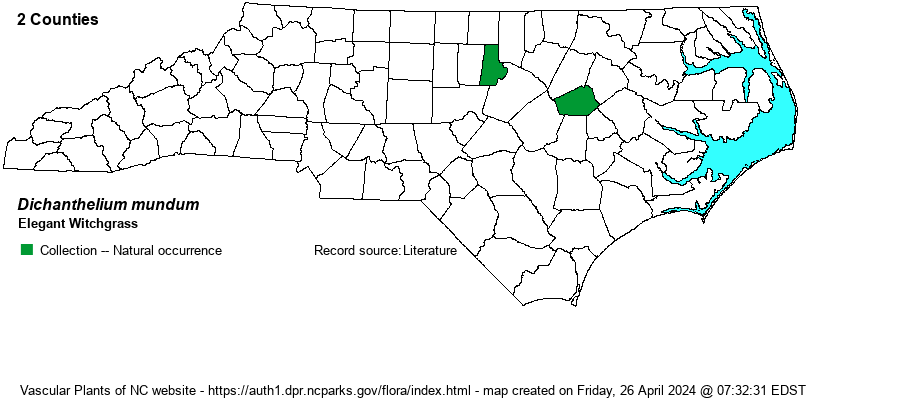| Author | (Fernald) LeBlond | |
| Distribution | So far, known in NC only from a collection in 1937 by Blomquist from Durham County and a Blomquist specimen from Wilson County in 1934 (specimens at DUKE). See LeBlond (2019) for discussion of this very scarce species.
Range poorly known; scattered from southeastern VA to northcentral NC, eastern TN and northern AL. | |
| Abundance | Apparently very rare, but no doubt overlooked. The editors suggest a rank of S1? and Watch List (W7) status until more is known about it in the state. It should not be assumed as Historical (SH). | |
| Habitat | Tha habitat in NC was not given by LeBlond, but probably was border of swamp or river marsh. | |
| Phenology | Spring to fall. | |
| Identification | See LeBlond (2019) or Weakley (2020) for keys. Most importantly, D. mundum differs from scabriusculum and cryptanthum by smooth (not scabrid) upper stem internodes and ciliate ligules (vs. non-ciliate membrane). The shorter spikelets (1.8-2.2 mm vs. 2.2-2.8) of mundum and retrorsely bearded stem nodes (vs. sparsely hairy) should separate it from recognitum. | |
| Taxonomic Comments | FNA considers it a probable hybrid of D. scoparium and D. dichotomum, which covers a lot of ground to say the least.
A note about Dichanthelium: This genus is not impossible to identify to species! But it takes applied effort over a period of time in order to learn the various species and what their morphological limits are. We strongly recommend that you read the introduction to the treatment in Weakley et al. (2023), written by Richard LeBlond. LeBlond has made order out of near chaos, and his keys work very well for our plants. Most Dichanthelium taxa ("Dichs") do not grow everywhere indiscrimminately, but prefer certain well-defined habitats. Note that most species produce flowers/fruits twice a year -- a vernal period and an autumnal period -- and that measurements of spikelets and achenes are taken from vernal plants. Some species also have a third, or summer, period. In the vernal period there is a single inflorescence at the tip of the stem. In the autumnal period, plants produce elongate branches with bunched (congested) leaves and so look quite different from vernal plants. Inflorescences are produced in leaf axils as well as at the tips of branches. NOTE: Older texts had these species essentially all within the very large genus Panicum. "Dich" species are typically named as "Witchgrass" and Panicum species named as "Panicgrass". | |
| Other Common Name(s) | | |
| State Rank | [S1?] | |
| Global Rank | GNA | |
| State Status | [W7] | |
| US Status | | |
| USACE-agcp | | |
| USACE-emp | | |

